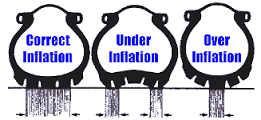Forum Discussion
rhagfo
Mar 09, 2015Explorer III
benb21601 wrote:Me Again wrote:benb21601 wrote:
You just proved my point. Correct inflation = what the tire was designed for. You can tell that by what's stamped on the sidewall. If the tire says 80, put it to 80. If the tire says 40, put it to 40. I wholeheartedly agree that over inflation is as bad or worse than under inflation. How can one possibly justify asking the tire to perform as intended while not giving it what it needs to do so? Your truck, your tire, your call. But as for me and the safety of my family, I will run the tire as the manufacturer intended.
Tires state "Max Load xxxx at Max yyy PSI inflation". Go take a look! They do NOT say inflate to 80 lbs (LRE). Call your tire manufacturers CS number and see what they say. Chris
So you would rather max the tire out by under inflating it rather than having the capacity it was built for? Every tire I have ever bought has come out of the shop/dealer fully inflated. If the tire wasn't intended to be run at a given psi, it wouldn't be stamped on the tire. I obviously don't understand the logic of not using all the capability you have.

Ok, so reference the picture above.
So assume I am running empty with about 3,400# on my rear axle. That is 50% of my my total rear tire capacity.
If running 40 to 45 psi the tire will look like the the tire on the left, CORRECTLY inflated for the load they are carrying.
If inflated to 80 psi with the same 3,400# load it will look like the tire on the far right.
Conversely, if the tire is inflated to 40 psi, and the load on the axles is 7,000# (MAX load) the tire will now look like the tire in center.
If the tires are now inflated to 80 psi, it will once again look like the tire on the left.
The result of correct inflation pressure for the current load, is MORE TRACTION, and longer tire life.
Remember that label on the side of the tire states MAX pressure for the MAX load!
About Fifth Wheel Group
19,027 PostsLatest Activity: Nov 07, 2025